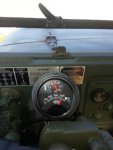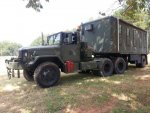Smokinyoda
Member
- 657
- 8
- 18
- Location
- Franklin, NC
I bought a late model M35a2c out of WR a while back. Truck was bone stock, FDC still hooked up, safety wire still on the IP. I was always amazed at the power the truck had, rarely had to downshift pulling a grade. Decided to bypass the FDC before it started making oil, and since every other truck I have done this to seemed to gain a little power I wanted to install a pyrometer first... wish I had done it sooner!
Installed a 24v Auber 1813 with an exposed tip K type thermocouple. TC mounted pre turbo, back side of exhaust manifold. On the first and only test run I hit 1250 F on a very mild hill before quickly deciding to abort the trip and head back home. Mind you this was not very steep, and I was not even wide open on the throttle. What worries me is I have taken this truck up 7% grades, 3/4 mile long without having to downshift... hate to think what kind of temps she saw... really surprised I still have a functioning engine. Truck is now parked until I get the fuel turned down!
Anyway just wanted to post this as a warning to other deuce owners. Dont be like me, ignorant in your thinking that a stock truck right from the Military would be properly set to a "safe" range! Or that pyros are only for those who plan to turn there fuel up!!!
Installed a 24v Auber 1813 with an exposed tip K type thermocouple. TC mounted pre turbo, back side of exhaust manifold. On the first and only test run I hit 1250 F on a very mild hill before quickly deciding to abort the trip and head back home. Mind you this was not very steep, and I was not even wide open on the throttle. What worries me is I have taken this truck up 7% grades, 3/4 mile long without having to downshift... hate to think what kind of temps she saw... really surprised I still have a functioning engine. Truck is now parked until I get the fuel turned down!
Anyway just wanted to post this as a warning to other deuce owners. Dont be like me, ignorant in your thinking that a stock truck right from the Military would be properly set to a "safe" range! Or that pyros are only for those who plan to turn there fuel up!!!






